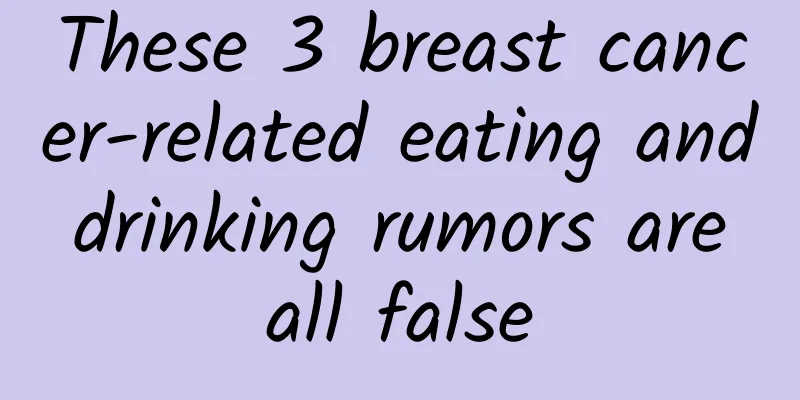These 3 breast cancer-related eating and drinking rumors are all false

|
At present, breast cancer has become the most common cancer in the world, with an incidence rate exceeding that of lung cancer. There are about 300,000 new cases of breast cancer each year. Especially for women, it is the top malignant tumor. With the popularization of health care knowledge, people are becoming more and more aware of the principle that prevention is better than cure, especially for some very common malignant diseases, there are always some folk legends such as "don't eat XX or you will be prone to XX disease". In our daily life, we often hear some rumors about eating and drinking related to breast cancer. Today, let's talk about the three most widely circulated typical representatives. 01 Does eating soy products often increase the risk of breast cancer? No The rumor that "eating soy products can cause breast cancer" has made many people afraid to eat soy products. But what is the truth? The theoretical core of this rumor is soy isoflavones. Soy isoflavones are one of the biologically active ingredients in soy products and are also a type of phytoestrogen. However, it should be made clear that there is a certain difference between soy isoflavones and the estrogen in the human body. First of all, it can indeed help regulate the body's hormone balance. For example, when the body's estrogen level is low, soy isoflavones can help increase estrogen; but don't forget that when the body's estrogen level is high, it can also play a role in lowering the estrogen level. Therefore, in general, soy isoflavones are a candidate for "replenishing when the level is low and resisting when the level is high". Not only will they not induce or aggravate breast cancer, but they are helpful in preventing the occurrence of breast cancer. Results from a number of studies have shown that soy and its products can reduce the risk of breast cancer and osteoporosis in women. [1] In addition, a study on diet and breast cancer showed that:[2] Fresh beans have a protective effect on female breasts, while various pickled and fried foods, especially fried fish/meat, fried pasta and fried peanuts, will increase the risk of breast cancer in women. Therefore, if you want to prevent breast cancer, you can't refuse soy products, but you have to eat them every day. So, how much is recommended? The Dietary Guidelines for Chinese Residents recommends that adults consume 105-175g of soybeans per week, or an average of 15-25g per day. However, the current soybean intake of urban and rural residents in my country is 10.9g, far below the recommended amount. [1] The amount of soy products corresponding to 25g of soybeans is about 1 fist of tofu shreds, 1 fist of tofu skin, or 5 mahjong-sized pieces of northern tofu. 02 Does drinking milk often increase the risk of breast cancer? No Thirty years ago, there were reports abroad that dairy product intake was positively correlated with breast cancer mortality [3]; and recently, a new study was published in the International Journal of Epidemiology - drinking milk may cause breast cancer. The study surveyed 52,795 women and followed them up for 7.9 years, with 1,057 breast cancer cases reported. However, the subjects were all middle-aged and elderly women in their 50s in the United States. [4] There is still a big difference between the dietary structure of Americans and that of our country, and the research subjects selected in the above studies are basically postmenopausal women. my country's "Dietary Guidelines for Chinese Residents" expanded the scope of the observation population to include Chinese, American and European women, a total of 1,184,236 people, and gave a clear view on the relationship between milk and breast cancer: the intake of low-fat milk and its products can reduce the risk of breast cancer; the intake of whole-fat milk and its products has nothing to do with the risk of breast cancer. [1] Therefore, there is no need to worry that drinking milk frequently will cause breast cancer. Milk is an important way for Chinese residents to supplement calcium. It should be drunk every day. It is recommended that people over 2 years old drink 300 ml of milk every day. 03 Will drinking too much coffee cause breast cancer? No The reason why some people say that drinking too much coffee can cause breast cancer is because of the caffeine in coffee, but in fact there is no need to worry. The latest research results on women's health show that: Caffeine consumption is not associated with an increased risk of breast cancer. [5] In addition, there is a meta-analysis on the relationship between coffee consumption and the risk of breast cancer, and the results also show that there is no clear relationship between coffee intake and the incidence of breast cancer in women. [6] Therefore, there is no need to worry that drinking coffee will cause breast cancer. So how much coffee is best to drink every day? The "Scientific Consensus on Coffee and Health" jointly released by the Nutrition and Health Institute of the Chinese Center for Disease Control and Prevention, the Food Hygiene Branch of the Chinese Preventive Medicine Association and other five institutions recently recommended that the average adult should control caffeine intake within 400 mg per day, which is 1.5 cups of American coffee (a large 473ml Starbucks American coffee contains 225 mg of caffeine). In addition, we need to remind everyone: Try not to add sugar to your coffee. Many instant coffees on the market generally contain added sugar to satisfy the public's taste. When purchasing, you should read the ingredient list carefully and be careful to identify it. Common added sugars include: white sugar, brown sugar, rock sugar, fructose syrup, glucose syrup, corn syrup, maltose syrup, honey, fructose, etc. For example, the instant coffee in the picture below contains glucose syrup and white sugar. From the nutritional composition table, we can see that the carbohydrate content is 11.2g/15g (one bag), which means that drinking one bag of instant coffee will consume about 11.2g of sugar. According to the recommendations of the Chinese Dietary Guidelines, the amount of added sugar intake should not exceed 25g/day[1]. If you drink a bag of instant coffee like this every day, you will almost reach 50% of the recommended intake. After finishing a bag and then eating other sugary foods, the sugar intake will easily exceed the standard. However, consuming too much added sugar will increase the risk of tooth decay, gout, obesity and diabetes, which is not good for our health. To summarize: To prevent breast cancer, you don't need to refuse soy products, milk and coffee, as these do not cause breast cancer. The key to reducing the risk of breast cancer is to have a healthy lifestyle, a good attitude, and a reasonable diet. In addition, regular breast examinations are also very important. References: [1]. Chinese Nutrition Society. Dietary Guidelines for Chinese Residents[M]. People's Medical Publishing House, 2016, 81.82 [2]. Tao Menghua, Jin Fan, Liu Dake, et al. A case-control study on the relationship between dietary factors and risk of breast cancer in women[J]. Chinese Journal of Oncology, 2003, 12(002):78-82. [3]. Qin Liqiang, Xu Jiaying, Wang Peiyu, et al. Research progress on the relationship between milk and its products and breast cancer [J]. Chinese Journal of Oncology Prevention and Treatment, 2007(17):1345-1349. [4].1 Fraser GE, Jaceldo-Siegl K, Orlich M, et al. Dairy, soy, and risk of breast cancer: those confounded milks. Int J Epidemiol. 2020 Feb 25. [5]. Caffeine has little association with breast cancer[J]. Anhui Medicine, 2009(6):662-662,662. [6]. Guo Shasha, Feng Xia, Yang Weili, et al. Meta-analysis of coffee consumption and breast cancer risk[J]. Chinese Journal of Preventive Medicine, 2019, v.20(12):7-12. Author | Xue Qingxin, member of Chinese Nutrition Society, registered nutrition technician, health manager, public nutritionist Review | Gao Chao, Associate Researcher, Institute of Nutrition and Health, Chinese Center for Disease Control and Prevention This article was first published on the "Science Rumor Refutation Platform" |
<<: What is the difference between fresh salmon and frozen salmon? How to choose frozen salmon
Recommend
Causes of breast tenderness before menstruation
Breast pain when menstruation is approaching may ...
When is the best time to check NT?
The NT test is a very important test for pregnant...
Why do I urinate a lot without drinking water?
Many female friends think that it is abnormal to ...
Does otitis media affect the fetus if the pregnant woman
A pregnant woman's body functions will underg...
Disadvantages of girls playing volleyball
Exercise is a way to help the body, but everythin...
Does astigmatism mean “unfocused vision”?
As usual, Dr. Jingcai promises that this is pure ...
Eating cake = being poisoned? Does it really take 51 days to metabolize a mouthful of trans fatty acids?
Many people are familiar with "trans fatty a...
How to treat breast lumps? These methods can eliminate lumps
Breast lumps are one of the common symptoms of br...
What are the pre-pregnancy check-ups for women?
What are the pre-pregnancy check-ups for women? M...
Women should be alert if they gain weight suddenly
We know that if a person suddenly loses a lot of ...
What should I do if I have a fever and my period doesn’t come?
There are many things in life that make women ang...
Female anal polyp pictures
In daily life, some patients feel something on th...
Itchy after menstruation
Many people feel that the vaginal area is particu...
Seven months pregnant with no pain
When a woman is seven months pregnant, she is alr...
What are the benefits of eating collagen for women?
Collagen is a term often used in many beauty prod...









